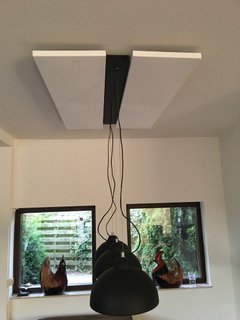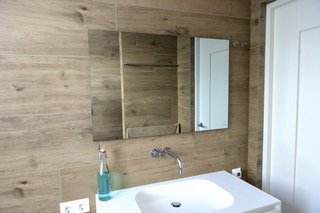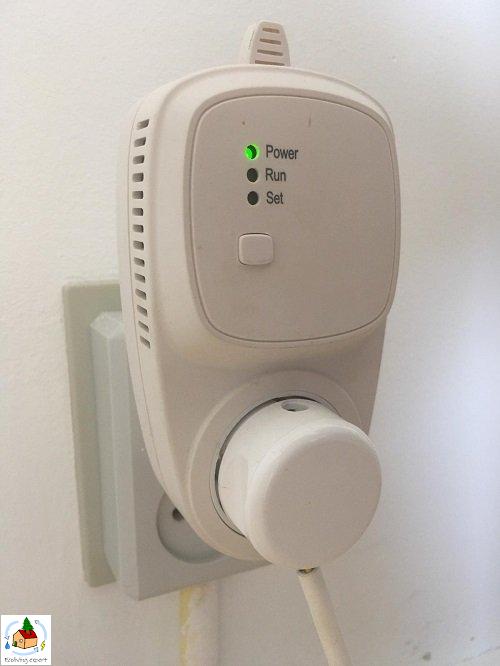Infrared heating panels can heat a whole house without the need for additional heating options. Infrared heaters are applicable in every room, including the living room, bedroom, bathroom, patio, garage, and large spaces. To heat a house, sufficient watts of infrared are required. On average, 7 watts per square foot is recommended. Proper placement of the heaters, preferably on the ceiling, ensures optimal performance.
I recently interviewed a friend who is heating her entire apartment with infrared panels. In this article, I discuss her situation including why she supplements with conventional heating during winter due to poor insulation. But first, my own experience.
How I ended up heating my home with infrared heating panels
About a year ago I moved into a new space that needs to be renovated entirely. However, for the upcoming winter, I needed a quick solution for heating. My criteria for heating included:
- keep me warm even when there is a draft
- needs to be as safe and healthy as possible, preferably no fuel burning
- have the potential to be a sustainable form of heating
- easy to install and use
My parents had a small 200W infrared panel mounted to a high ceiling, and it did not seem to do anything for them. However, it got me interested in this type of heating, and I started doing some research.
I quickly found that infrared heaters are exceptionally suitable for:
- Zone heating: heating only the desired area (a draft is not an issue)
- creating a healthy indoor environment: no gasses are released and the air is not being circulated
- running on electricity means you can purchase green electricity or run on solar panels
- infrared heaters are very easy to install and do not require any large infrastructure
This actually meant they seemed perfect for my needs, so I decided to test them out. I bought two infrared heating panels with a total of 1000 watts of heating. One small 300W panel and a large 700W panel, which I hung on the walls in the seating and kitchen area.
They work exceptionally well! I am very happy with these heaters and it inspired me to write about them on this blog. If you want to know all the details about my experience, I recommend reading my article: Infrared heating panel experience: a wonderfully different kind of heating.
Now, let’s get into the details of whole house heating.
Whole house infrared heating: all your questions answered
In this article, I will discuss:
- What type of infrared heaters are required for whole-house heating
- Are these infrared heaters applicable in every room?
- Can the room temperature be controlled when using infrared heating?
- Case study: heating an apartment with nothing but infrared
- Advantages and disadvantages of infrared heating compared to a gas-based heating system
- How many watts of infrared you need to heat your house
- The running costs of infrared heating
What type of infrared heaters are required for heating a whole house?
Infrared panels are the best way to heat a whole house with infrared. They are easy to install on the ceiling or walls where they take up very little space. Additionally, they can be used in every room, including the bathroom.
Infrared heating panels are ideal because:
- they take up almost no space, especially when mounted on the ceiling
- they make no noise,
- have no moving parts,
- require no maintenance, and
- can be attached to a thermostat to control the room temperature
Additionally, they can blend into the room by:
- looking similar to the ceiling in smooth or textured white,
- can be purchased with a picture of your choice to act as a piece of art, or
- are available as a mirror (which is especially ideal in the bathroom)
Here are some examples of ways to install infrared heating panels:



Are infrared heaters applicable in every room?
Infrared heaters panels are applicable for heating in any room. Although some heating systems can cause problems in the bathroom due to moisture, infrared heating panels can be used without any problems. They are water-resistant and are even available as a bathroom mirror. (portable infrared heaters should not be used in the bathroom)
The most important thing for realizing a whole-house infrared heating system is whether you have enough space to mount the panels. They need to be installed in such a way that they can emit their warming rays without any obstructions such as furniture. Therefore, mounting them to the ceiling is preferred. For wall mounting, the panels and furniture need to be carefully arranged to prevent blocking the infrared rays.
Can the room temperature be controlled when using infrared heating?
A combination of infrared heaters and a thermostat is perfectly capable of controlling the temperature of a room. Although infrared heaters are designed to heat objects and people rather than the air, the room temperature will increase to the desired temperature set by the thermostat. There is no need for additional heating sources.
Infrared heating is designed to heat people and objects directly, rather than heating the air as conventional heaters do. However, since objects and people give off their heat to the surrounding air when warm, infrared heating does increase the room temperature. I greatly prefer infrared to conventional heating since infrared heats me first, and only secondly starts heating the room. In this way, I do not need to wait for the entire room to get heated before I benefit from my heater.

To go with the thermostat in the picture above, the infrared heating panels are each plugged in with a smart power plug. This power plug is wirelessly connected to the thermostat and will stop providing power to the panels when the desired temperature is reached. In turn, it will provide power again when the room temperature drops below the desired temperature.


I wrote an article for you to find out and calculate how long it will take to heat your room with infrared heating. you can find it here: How long does it take an infrared heater to heat a room?
Case study: heating an apartment with nothing but infrared
I recently interviewed a friend who is renting an apartment in which the living room, kitchen, and bedroom are solely heated by infrared heating panels. Let’s dive into the details!
Infrared heating with a thermostat
The areas in my friend’s apartment that are heated by infrared are about 240 square feet (22 square meters) in total. This entire area is about 1765 Cubic feet (50 cubic meters). It has relatively poor insulation and the roof is not fit for the mounting of infrared panels since it is too steep (horizontal is ideal for heat distribution).
This entire area is heated by three of the following 750-watt panels, leading to a total of 2250 W of heating.

She reports that it is definitely possible to create a comfortable 70 degrees Fahrenheit (21 degrees C) with her infrared heating panels alone (as can be seen in the thermostat picture above). And that’s with relatively poor insulation!
How efficiently is she heating her apartment?
As a general rule of thumb for heating, 10W per square foot is required. Since she has 2250 W and 240 sq. Feet. She uses about 9.4 W per square foot.
That is excellent! Even with poor insulation, the infrared heating panels perform above average.
This is a clear indicator that infrared heating panels really are more effective heaters. Normally, with good insulation, about 7 W per square foot is recommended for infrared heating. In this case, with poor insulation, energy use below 10W per square foot is excellent.
And it could be better: as you can see in the picture, the panels are hung from the walls instead of the ceiling. In this way, these panels are a little less effective because furniture can block the infrared rays from reaching far into the room.
When infrared panels are mounted to the ceiling, they can freely disperse their warmth throughout the room and work optimally. If you want to know more about why infrared heaters are more effective heaters, please read my article: How effective are infrared heating panels? (personal experience).
What are the advantages of infrared whole-house heating over conventional heating systems?
Infrared heating panels are perfect for whole-house heating. While gas-based heating systems require piping, and a furnace, infrared heating panels only require to be hung from the ceiling or walls. No need for expensive and difficult-to-install infrastructure. The panels can directly be connected to the electrical grid in your house or be plugged into a socket.
Other advantages include:
- little to no maintenance is required. Sporadic cleaning of the panels is sufficient.
- Infrared heating panels are very durable and will last for about 100.000 hours (they can run 24/7 for 11 years!)
- Infrared heating does not dry out the air (therefore you will have fewer issues concerning dry air such as a dry throat or irritated eyes)
- Infrared heating is beneficial for indoor air quality
Infrared heating improves indoor air quality
Normally, a gas (or other fuel-based) heating system has a negative effect on indoor air quality. By burning a fuel, tiny particles are released that are harmful to our health, similar to traffic emissions. Additionally, burning fuel always creates a carbon monoxide hazard.
On top of that, regular heating systems create warm air, which results in an increase in airflow in your house. This has negative effects on air quality since dust and other harmful particles are being circulated and therefore more easily inhaled.
Infrared heating prevents all this and is therefore very beneficial to your indoor air quality.
You can read all about the differences between infrared-based heating and gas-based heating in my article: Infrared heating vs gas (running costs, application, health and safety).
Are there any disadvantages to infrared whole-house heating?
Although infrared heating is an excellent choice for whole-house heating, there are some disadvantages. The main disadvantages of infrared heating are:
- electric heating is relatively expensive
- infrared heaters require sufficient space around them to distribute their heat (for example, they cannot be installed behind the couch)
You can read all about the pros and cons of infrared heating in my article: Infrared heating pros and cons (personal experience).
How many watts of infrared heating do you need to heat your house?
Each room has different heating requirements. The following table shows the required watts for the different rooms.
| Room type | Infrared heating: wattage per sq. ft (0,1 m²) |
|---|---|
| Living room | 7 W |
| Bedroom | 4.5 W |
| Bathroom | 9.3 W |
| Closed porch | 9.3 W |
| Open outdoor area | 28 – 56 W |
This table is based on information from an infrared heaters supplier and assumes excellent insulation. If you have average or poor insulation, I recommend multiplying the required wattage by 1.15 for average insulation and 1.25 for poor insulation.
To calculate the total number of watts that are required in your house, please use my wattage calculator below.
Here’s my wattage calculator
I created a wattage calculator to get an indication of the number of watts you will need for your house. You can find it here:
What are the running costs of infrared heating?
Although infrared heating is a very efficient form of heating and requires very little energy, the electricity price is much higher than the price of gas. Therefore, the running costs of electric infrared heating will be higher than running a gas-based heating system.
The average electricity price in the United States is 13.31 cents ($) per kWh, while the gas price is 3.8 cents ($) per kWh. (based on the average US gas price in December 2020).
As a general rule, infrared heating is about 40% more efficient at heating. Therefore, it will use 40% less energy to create the same level of comfort. However, even with this low energy use, the price of electric heating still exceeds the price of running a gas-based heating system.
The following table shows the running costs of infrared heating vs gas-based heating. This table is based on heating an average 330 square foot US living room that has medium insulation. The required amount of energy for heating this room with infrared is 2300 watts. The required amount of energy from gas is 3300 watts.
| Time | costs infrared ($) | costs gas ($) |
|---|---|---|
| One hour | 30.6 cents | 12.5 cents |
| Day (6 hours) | 1 dollar and 84 cents | 75 cents |
| Week | 12 dollars and 86 cents | 5 dollars and 27 cents |
| Month (30 days) | 55.1 dollars | 22 dollars and 57 cents |
For more information about the energy use of infrared heating compared to gas-based heating systems, I recommend reading my article:
If you are considering purchasing infrared heaters for your home, I recommend first reading my article about all the pros and cons of infrared heating. You can find it here:


